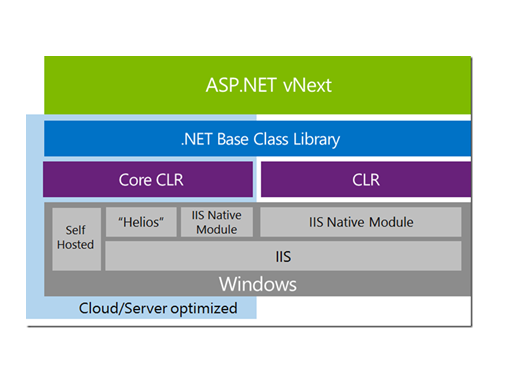There are lots of changes in the software development fundamentals since past few years. The developers want to work cross-platform and open source development strategies with faster speed also they want to integrate the old applications with the new technologies easily. The .NET Framework come up with a new version called ASP.NET 5 as an effort to fulfill these demands of developers.
ASP.NET 5 (vNext) has many new features as compared to the older versions such as modularity, support of cloud based, cross platform and open source application development, faster development cycle and freedom to select programming tools. It is currently in its preview release, features can be updated.

ASP.NET 5 Features
There are many great features in the preview release, which we can use today.
1. Flexible and cross-platform runtime
ASP.NET 5 consist three different KREs K-runtime environments: Full .NET CLR, Core CLR (for Windows) and Cross-Platform CLR (for Mac and Linux).We can choose any of them depending on our needs:
1.1. Full .NET CLR
It is the default runtime. If we want our previous application to be compatible with new ASP.NET 5 then this is the best option as it provides the entire API set.
1.2. Core CLR (Cloud-Optimized CLR)
The Core CLR is modular runtime. This CLR provides flexibility to choose and include only the feature we want in our application. These features are being added as NuGet packages. This way our app is dependent only on the required features. The Core CLR is about 11 megabytes in comparison to the full .NET CLR which is 200 megabytes. Each component is updated individually thus quickly as it has its own schedule. Different version of Core CLR can be run side-by-side and can be deployed with your app.
1.3. Cross-Platform CLR
The Cross-Platform CLR will enable us to develop and run applications on the devices running on Mac and Linux operating system. Mono community can be used for cross-platform development until this runtime is released. A web server called kestrel will be used for Mac and Linux which is built on libuv in ASP.NET 5.
2. Open Source
.NET is going to be open source and using its principal it will allow us to run applications on multiple operating systems. The source code for ASP.NET 5 is hosted on GitHub, within the .NET foundation org.
3. Unified model which combines MVC, Web API, and Web Pages
MVC, Web API and Web pages will be merged into a single framework called MVC 6 in it. This will remove duplication and makes it easier to develop apps that use these programming frameworks. We do not need to write different code depending on the framework.
In the preview version, MVC and Web API have been unified; Web pages will be merged in later release.
4. Totally Modular, opt for the features you want
One of the major features of ASP.NET 5 is total modularity. In the past versions of .NET; to run our application the whole .NET Framework was required to install. This requires more storage space on disk. Also it causes more problems when we want to run application in a different .NET version than the one in which they were developed.
It relies on features organized as packages. Therefore, all the dependencies are built as Nuget packages that are deployed together with the application. To optimize resources for the cloud it is divided into two parts: one for on premise solutions and the other for cloud application. The cloud optimized framework contains only the resources that are required from the deployment of an application on cloud nothing else.
In web application the web.config file is being replaced by project.json in which we can select which package and its version we want to add in our application. This json file is used in all type of projects.
5. See changes without re-building the project
VS 2015 with ASP.NET 5 allows you to make changes in your code, there is no need to rebuild the project just refresh the browser and the changes can be seen. These changes may be in the project itself or in any class library.
6. Faster Development Cycle
ASP.NET 5 has dynamic compiler called Roslyn. The dynamic compilation is performed in the system memory and does not require rewriting of assemblies on disk; it results in speed up performance to the execution of an application. Once the application process is started we can change the source code and after saving it we can see those changes in real time. It makes faster software implementation, easy bug fixing and increases productivity.
7. Side-by-side versioning
Perhaps, someone wanted to use the latest version of .NET but was unsure whether the application would work appropriately with the new version.
Good News guys..! Now we can define the dependencies within our deployment package, so that we can get the advantages of the new releases for some applications and we can also easily stick with an older version for other applications. All the different versions run side-by-side using the Core CLR.
8. Self-host or host on IIS
It allows us to host the application on IIS or self-host the application in our own process. When we use the Core CLR, we can deploy the application with all dependencies contained within the deployment package. That is why; our application and its dependencies are self-contained and not dependent on system installation of .NET. As a result, any type of device or hosting platform can run the application. Our hosting preference no longer dictates which development framework to use, and vice versa.
9. Transition from on-premises to cloud
Its cloud optimized and integrated with Azure. You can publish your website directly to Azure. Diagnostic and tracing tools are also provided which makes discovering issues easier. The Core CLR was introduced with benefits like xcopy deployable and lightweight in general.
10. New tools in VS 2015
VS 2015 uses Roslyn compiler which enable dynamic compilation. It is faster as it operates in-process and does not required configuration. Combined with cross-platform development tools, it allows using a Mac machine to make changes in the code and upload it to server back without MSBuild or VS just using a plain text editor. We are no longer restricted to package and deploy assemblies to the server. We can easily transit between using the interface and writing command line scripts. Following are some editors we can use with ASP.NET 5:
• Visual Studio, Test, Cloud Editors
• OmniSharp-Sublime, Emacs, Vi, Atom, Brackets etc
• No editors (command line)
Conclusion
ASP.NET 5 represents a new aspect of .NET framework, where developers are allowed to work with the tools and operating systems of their own choice, since it is open-source and cross-platform. ASP.NET 5 has many other advancements including merging of MVC, Web API and Web Pages in a single package and modularization. Multiple versions of the same application will be able to run simultaneously.
ASP.NET 5 will take the way of application implementation to a new level. But we have to wait more for its official release to explore all the features provided by it.


